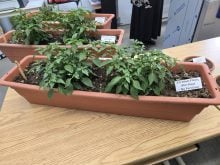You will need a container — a rectangular one works best if you are planning to locate the dish garden on a windowsill. In fact, it is a good idea to decide where you want to display the garden — choose a location that gets some direct sun — and then choose an appropriate container. A ceramic one with no drainage holes works best so you won’t have to worry about trays or water damaging furniture surfaces. Choosing a container without drainage holes does require that you are careful not to overwater the garden.
Read Also

Local farm businesses, groups look forward to Manitoba Ag Days 2026
Most of agriculture is seemingly at Manitoba Ag Days each January: Manitoba agribusinesses and farm groups look forward to connecting with farmers at the 2026 show.
You will need a planting medium. There is a wide variety of potting soils available; choose one recommended for cacti. If you cannot find such a mix, purchase ordinary potting soil and add some perlite and sand to create an appropriate mix. The soil must be loose and have excellent drainage — cacti and succulents do not flourish when planted in heavy soil.
Finally, you will need some plants. Use those you have or offshoots from them to save having to buy all the plants. Select small specimens so that the dish garden will not have to be disturbed for quite some time. Be careful not to choose a fast-growing plant that will take over the garden and create imbalance within your design. I like to choose plants that have a variety of textures and forms — some round, some vertical, some with spines and some smooth. Cacti and succulents range in colour from dark green to bluish green so aim for variation of colour as well as texture.
Planting the garden is as simple as placing some of the soil mix into the container, slipping the plants out of their pots and positioning them in the garden. Give each plant enough space and move the plants around until you have a pleasing arrangement before filling the container with planting medium and settling the plants into position.
It is a good idea to water the plants you are using the day before you undertake the planting so that the root balls are moist. After the garden is planted, water just enough to settle the soil around the plants, being mindful that the soil around the plants’ roots is already moist enough.
I like to finish off such a dish garden by smoothing the top of the planting medium with the bowl of a spoon to push down any lumps or pieces of perlite. Add some sand to cover the soil surface, perhaps add a few polished stones, a small piece of driftwood, and/or a couple of decorative objects. I have a couple of small ceramic figurines of frogs and turtles that serve this purpose quite well. Place your dish garden in a sunny spot and rejoice in the fact that you have done some gardening today!














